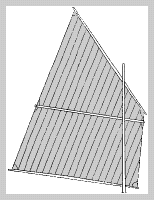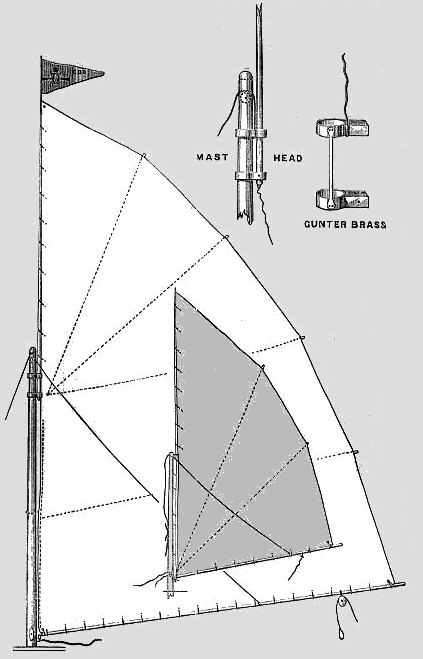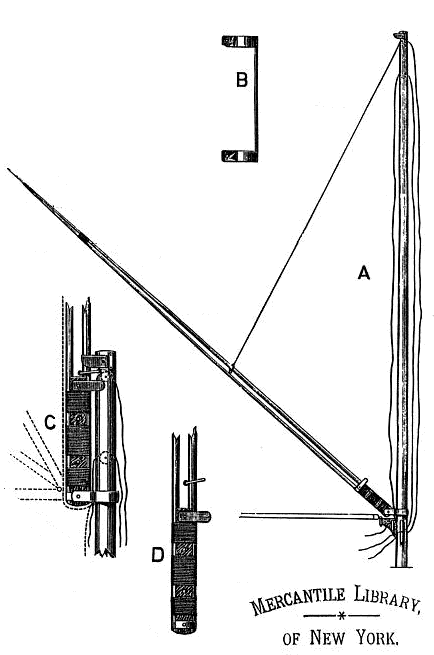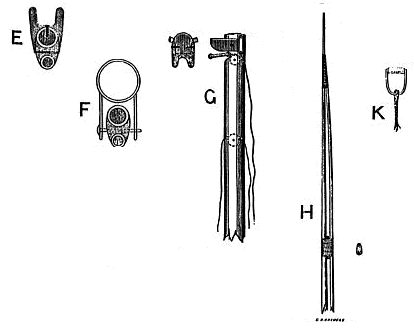
THE NEXT Illustration is of the Batswing Sliding Gunter, which was described as follows in a recent number of the Field by Mr. C. Penrose, R.C.C. It is a pretty rig, but cannot be readily taken off the mast; however, it is easy, by lowering the mast, to stow the whole rig away altogether. The length of the whole affair, allowing 4 inches from boom to deck and 11 inches housing of mast, will be 8 feet 3 inches over all. Its area without the battens would be about 35 feet in mainsail and 8-1/2 in mizen.
"This rig has stood the test of eight or nine years, and combines to a great extent the good qualities of the sprit-sail with those of the lug. I believe it was brought out by Patrick, the well-known and successful boat builder and boat-sailer, of Lincoln."About the second or third suit of these sails was made for my first sailing canoe in 1876; and, after hard usage and little care, only required a little mending at the corners and eyelets to be nearly equal to new in 1882.
"The rig consists of an ordinary sliding gunter mast and topmast, or, as some prefer to call it, gaff, carrying a sail of elliptical form, containing nearly 1/4 more area than a triangle of the same height and base. There should be a batten at each reef, of which there may be two or three, and one or more battens in the head dividing the leach equally.
"A downhaul should be fitted to the gunter brass and another to each reef; or of course 'patent' reefing gear may be fitted, which will act better with this rig than with the lug, because the gear has not the strain of peaking the yard. When the gunter brass has been lowered, the boom may be topped up to the mast, which for light airs is sufficiently snug, but in stronger winds something further is required.
"I have tried several dodges for lowering the "gaff" cutter fashion upon the boom with more or less success but probably the handiest plan is to lower the mast and all. When lowered, the masthead will fall right in front of the canoeist, and, by taking off the collar which holds [the] forestay [to the masthead] the mast can be drawn aft and stowed below, leaving nothing on deck but the stay, and can be set up while afloat with equal ease. The heel of [the] mast must of course be made to pull out of the tabernacle when lowered.
"In the drawing, the rig is shown with two reefs, besides which a balance reef may be made by lacing the third batten to the boom. The mizen is something like Mr. Tredwen's sprit-mizen, but has two battens instead of one, to look more in keeping with the mainsail. With this mizen stepped forward and a small storm-mizen aft, the canoe will sail in almost any wind; and mine has repeatedly sailed in ease and comfort when the local sailing boats were capsizing in all directions. The dimensions of the sails in the drawing, as fitted to a 16-feet canoe, are nearly the same as carried in the 14-feet canoe rigged with them in 1876, the difference being that the old rig had one more reef and one more batten in the head.
"The dimensions are:
|
Mainmast above deck: |
5' 8" |
||||||||
|
Topmast, heel to shoulder: |
6' 6" |
||||||||
|
Boom |
7' 0" |
||||||||
|
Mainsail: |
|
||||||||
|
Mizen (spars to suit): |
|
||||||||
|
First Reef |
-14.5 sq ft |
||||||||
|
Second Reef |
-12.5 sq ft |
||||||||
|
Main, Close-Reefed |
17.0 sq ft |
"Now for the advantages of the rig. In the first place, anyone can cut, fit and rig it without difficulty. A boat is stiffer under it than under a lug. The sail sets flatter than nine lugs out of ten, and in a squall the wind can be sailed out of it without its flapping about.

"When lowered and brailed up it can be removed from the boat as easily as an umbrella, can be stowed below all ready for setting again, instead of having to be unhooked and untoggled from a lot of fastenings. Also it is short enough to travel easily in a railway carriage, instead of requiring the largest size of van, or having to be lashed outside the train, as has happened now and then with the long-masted lugsails common in the Royal Canoe Club."The advantage of being free from all top hamper is very great, especially if sea sailing is indulged in, while the power of stowing the sails below leaves the canoeist only one thing to attend to, house, &c., viz., the canoe, instead of two, viz., canoe and sails.
"This makes no little difference when the canoe has to be housed in strange quarters or in a crowded boathouse. While the lugsail canoeist is 'setting' his delicate and complicated gear, ashore, perhaps in difficulties in finding a spot for the purpose, secure from waves or from barge's bow lines; the gunter sailer can put his boat in the water as if she were a paddling Rob Roy and set his gear up at anchor or as she drifts with the tide.
"I do not think this rig would suit very large areas or be good for racing against lugs, but for all round work in light and narrow canoes, I know nothing to equal it for ease in working, safety and lightness. The appearance is good and the falls of the lines on deck are shorter than with any other rig."
I am indebted to Mr. C. Whistler for the following account of an improvement in this rig, allowing the sail to be entirely lowered, and giving additional support to the topmast when reefed:
"The original form of double sliding brass, with which the ordinary sliding gunter is fitted, does not allow of the sail being lowered on deck, unless the mast is lifted bodily from the step; while it is only by unlacing the head of the sail from the topmast that it can be unbent for stowage."The advantages of being able to lower the sail easily and quickly -- leaving only the short lower mast set during a paddle to windward -- are evident, as the brailed up canvas of the ordinary gunter sail still offers a large surface to the wind. The present rig answers both requirements and has the further recommendation of being extremely light. In it, the upper ring of the original sliding brass (Fig. B) has been dispensed with, leaving the topmast itself free to travel though a shackle at the masthead which takes the place of the original upper ring - as will be seen in Fig. C, where the topmast is shown hoisted.

"By slacking off the line leading to the shackle the topmast is lowered and raised, hinging on the fid of the brass (Fig. A), the line thus forming a kind of peak-halliard; while by leaving the shackle fast at the masthead the topmast can be lowered as in the ordinary sliding gunter.
"The topmast made of two light battens, plugged and whipped, the stouter about 1 inch diameter at butt, the slighter, forming the batten, about 3/4 inch. At the foot (Fig. D) they are connected by a block of hard wood 9 inches in length, hollowed fore and aft to fit the canes, leaving sufficient space between them, for the shackle to render without touching the lacing on the batten. To this block they are lashed, leaving a space free above for the jaws shown in Figs. D and E, and intermediate spaces pierced for the lashing of the sail.
"The heel of the topmast is pierced for the fid of the sliding brass (Fig. F), and protected by a brass ferrule drilled to correspond.
"The jaws, which are are necessary to prevent the topmast sagging to leeward owing to the brass twisting round the mast, are of oak, and made in one piece, screwed to the block and plug of the topmast cane, and fit the mast itself (Fig. E).
"Up to a height corresponding to the measurement between masthead sheave and foot of sail the bamboos are left free, but at this point they are again connected by a similar, but smaller block, And lashed securely, previous to which the shackle, which is a solid brass U shaped ring with a roller to take the topmast, must be slipped on the stouter cane. The topmast-head is finished by bringing the canes together, bevelling the smaller down to nothing to fit the other, lashing them at the point of contact, and leaving the topmast cane to carry up the remaining few inches required (Fig. H).
"The masthead (Fig. G) is also provided with jaws, to prevent the topmast from turning bodily to leeward, and to give support to the topmast-head when sailing close reefed, so preventing the strain on the heel of the topmast. They are made of oak, and the masthead is squared to take them. In Fig. G and the section the sheaves are topping lifts are shewn on a level; with the jaws and slightly forward of them. Immediately below them is the sheave for the line leading to the shackle, and 7 inches below it the sheave for the main halliard leading to the sliding brass.
"The dotted lines in Fig. C show the arrangement of the sail and battens. In Fig. A the gooseneck for boom is shewn mounted on a bracket to give more room for battens and boom in topping up. The downhaul and reef pennants lead through small sheaves on the sides of the bracket.
"By simply unshipping the topmast from the sliding brass, and the boom at the gooseneck, after the line to the shackle has been unrove and the toggle on the first reef cast off from the ring, the sail is left only with the two light spars - not more than the boom and yard of the lugsail.
"In Fig. A, the free space between the topmast and batten has been unavoidable left too short, in order to shew the whole of the topmast. The length of spars, of course, depends on the amount of sail carried, but in a sliding gunter at present in use the height of lower mast is 6 feet, and of topmast 7 feet 6 inches, with a clear space between the cane of 4 feet 9 inches, giving a hoist of sail of 12 feet."
The lateen rig has been a good deal used in England of late years , notably on the Norfolk waters. It is not very suitable for canoes, at all events for cruising, being difficult to reef and impossible to stow. The mast required is very short, and the strings few and simple. A halliard and sheet with a topping lift are all that it wants. A tack may be added, or the boom kept to the mast by a crutch. [A, Mast; B, Boom]
The rig has been still further simplified by some American canoeists, hanging the sail by a ring to a spike on the mast-head by hand and omitting topping-lifts. The sail has thus only one rope. This sail would do for any one living by the river, for sailing in light winds in his home reach. Taking the time to set and get ready it would often be handy for an hours sail in the evening. The yard should be nearly up and down - the more so, the better the boat will carry it.
One of the simplest rigs I ever saw in a canoe consisted of a main and mizen, each resembling the mizen shown with the sliding gunter. No halliards, only sheet and brail. One small triangular reef could be taken in each sail, for more wind the mizen was shifted forwards and a very small mizen set. Of course the mainsail was only given an area which the boat could carry in a good breeze, and sailing in very light airs was not to be attempted. The rig would be first-rate for a beginner. To take the sail off lower mast and everything. The mizen also was made to lower, one line lowering both sails into crutches kept on deck for the purpose. This was for the numerous low bridges on the waters this canoe frequented. I have sailed in her, and though 14 feet by 36 inches beam, and very heavy, she seemed to slip along nicely under some 50 feet of sail.
Dimensions:
luff
foot
Main
7 feet 9 inches
7 feet 6 inches
Mizen
4 feet 6 inches
4 feet 4-1/2 inches
Leach of both sails well rounded.
The following sizes of line will be found most serviceable:
Main
Halliards
laid hemp
5/16-in diameter.
Tack
"
"
Sheet
laid cotton
"
Topping Lifts
laid hemp
3/16-in.
Mizen
Halliards
laid hemp or Manilla
"
Sheet
"
"
Topping Lifts
"
"
Reef Lines
plaited flax line
1/4-in.
" Hauling Part
"
3/16-in.
Painter
"
7/16-in.
It is useless to give the sizes of blocks as these small blocks vary so much in form, but they must take their lines quite freely, and be easy running, with good broad brass sheaves and brass pinned.
In conclusion, let everything be as strong and light as possible, not sparing trouble to make it so. Lightness must be had without sparing strength at the vital points of the rig. You never know what may depend on the strength and goodness of your gear. Fit everything, then, as if it were for a balloon where strength is everything and lightness all the rest. The difference in stiffness between a properly light rig and some clumsy ones is as good as a reef.
A glance at deck fittings, and then we can leave rigging and get to sailing, which to my mind is the pleasantest part of it, though I believe some canoeists take even more pleasure in making and planning, than in using their gear.
Most of our blocks are on the masts and sails, but there must be at least the stay block on stem, the mizen sheet block, and the downhaul, if for a lug. Thimbles or wooden bullseyes may be used for the two latter, which must be securely stropped with grommet strops to brass screw-eyes. The stay block should have a wire strop through stem-head, the end of the tackle being spliced into the strop at the end of the block. Screw-eyes should be fixed in the side decks, and the end of each line put through one, "figure-of-eight" knots being tied in their ends to keep them m from going adrift. Each screw-eye should go through a round brass plate with a hole in centre. These, as well as the eyes, can he had at Nettlefords, High Holborn. They prevent the eyes getting knocked into the wood by a blow or pulled aside by the strain, and add greatly to neatness of appearance.
In the wake of these should be the cleats, carefully arranged within reach of hand. The following is my own arrangement, but let each man suit himself, as some are more left-handed etc., than others.
- Starboard side :
- stay tackle
- main halliard
- fore centre-board line
- after centre-board line
- mizen sheet.
This is their order from forward aft.- Port side :
- main tack
- reef lines
- downhaul
- topping lift
- mizen brail or halliards.
The reef lines and downhaul should be the contrary side to halliard, that they may be held in one hand and it in the other in reefing and lowering. If I have a lug mizen I use standing mizen topping lifts, i.e., fast at masthead. If there is a mizen reef the reef pennant should lead on port side and the halliard to starboard.
For cleats, the ordinary brass boat-cleats are not very suitable, requiring too many turns and a hitch over all. All canoe cleats should hold with a couple of turns without hitching. Paget's patent rocker cleats are very commonly used. They hold
with one turn, but are clumsy looking, and, large or small, are all made for one size of line, that is, blind cord.
There is a round headed cleat sold for blinds, which I call the "Sunflower", I don't know its trade name. It must be fixed with its head towards the strain, niche one turn will hold anything if the pull is steady, but if played fast and loose" with, it will not hold.
Now for home-made cleats. Mr. Mc Gregor (Rob Roy) invented leather cleats. They are very good for light work, such as a mizen brail. They are simply stout leather cut to shape, and screwed with two brass screws to deck.
Several of the R.C.C. canoeists have home-made brass cleats,
made of a strip of stout flat brass filed round at the corners and ends, bent up a little, and screwed to the deck.
As good as anything are well-made ash cleats, which anyone one can make for himself. Each cleat should just admit the line to jam between it and the deck. They are light, and like the leather cleats, they do not injure the hands or the paddle that happen to come against them.
